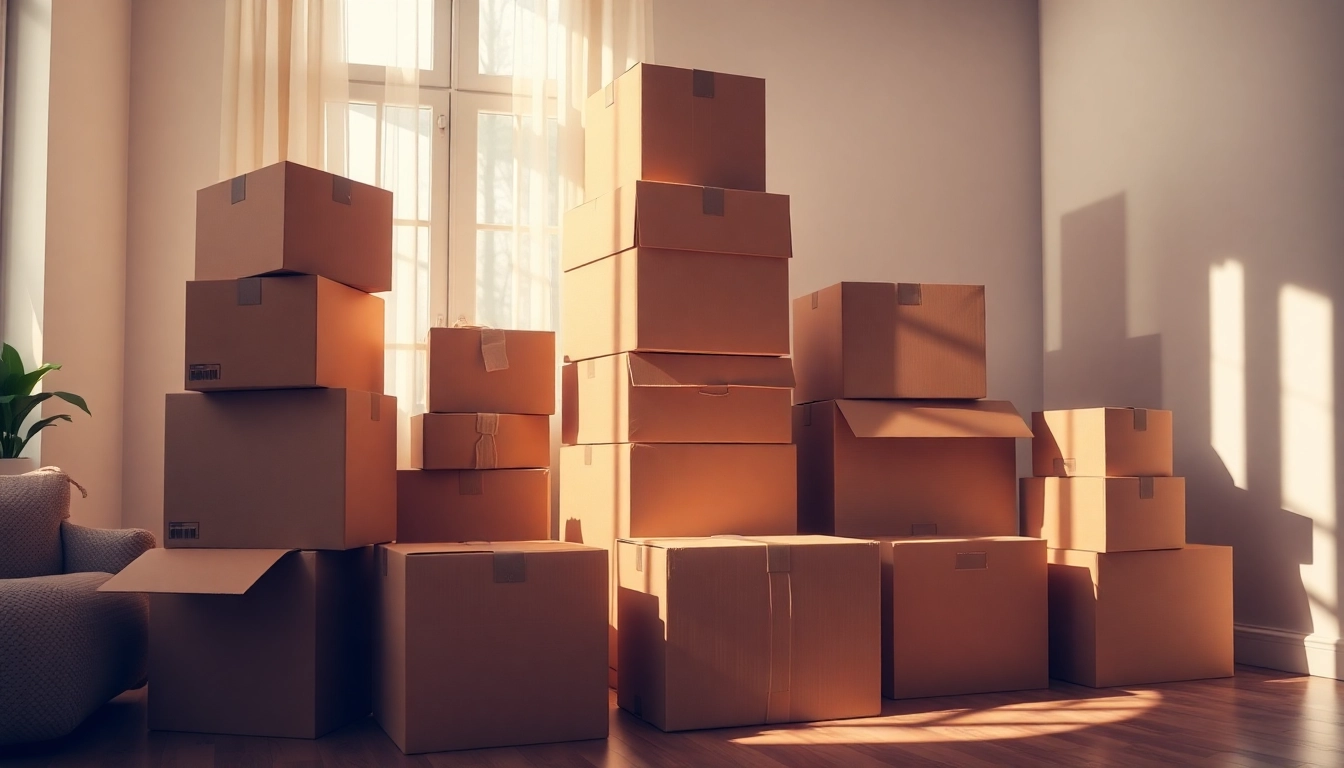Understanding the Types of Moving Boxes
When preparing for a move, selecting the right moving boxes is crucial. There are various types of boxes designed specifically to accommodate different items, ensuring the safety and security of your belongings during transport. This section delves into the most common box types, helping you make informed decisions based on your needs.
Standard Box Sizes for All Your Needs
Standard moving boxes come in several sizes, each suitable for different items. Here are the most common sizes you’ll encounter:
- Small Boxes (1.5 cu ft): Perfect for heavy items like books, DVDs, and kitchenware.
- Medium Boxes (3.0 cu ft): Ideal for clothing, toys, and small appliances.
- Large Boxes (4.5 cu ft): Best for lightweight, larger items, such as linens, pillows, and miscellaneous goods.
- Extra-Large Boxes (6.0 cu ft): Suitable for large, bulky items like blankets or pillows.
Understanding these sizes and matching them to your items will help you pack more efficiently, minimizing the risk of damage and optimizing space.
Specialized Moving Boxes for Fragile Items
In addition to standard boxes, there are specialized options for items that require extra care. For example:
- Dish pack boxes: These are thicker and provide extra padding for fragile dishes and glassware. They often come with dividers to keep items separate.
- Wardrobe boxes: These tall boxes come with a hanging rod, ideal for transporting clothes on hangers.
- TV boxes: Specifically designed for flat-screen televisions, these boxes come with foam inserts to prevent movement during transport.
- Mirror and picture boxes: Adjustable boxes that can fit various sizes of frames to protect them during your move.
Investing in specialized boxes is crucial when it comes to protecting valuable items. Utilizing these boxes can save you the hassle of replacing damaged goods.
Eco-Friendly Options for Sustainable Moves
In today’s environmentally conscious world, opting for eco-friendly moving boxes has gained popularity. These boxes often offer the same durability and functionality as traditional options but are made from recycled materials or are fully recyclable. Some features of eco-friendly moving boxes include:
- Biodegradability: These boxes break down naturally over time, reducing landfill contributions.
- Reusability: Many eco-boxes can be reused multiple times, promoting sustainable practices.
- Post-consumer recycled content: By using materials that have already served a purpose, these boxes help reduce the demand for new resources.
Choosing eco-friendly options not only helps your move but also supports environmental sustainability. It’s a simple way to lessen your ecological footprint while managing your move effectively.
Where to Purchase Affordable Moving Boxes
The next step in your moving preparation is sourcing the right boxes. The following sections highlight both physical and online resources where you can purchase quality moving boxes without breaking the bank.
Local Retailers Offering Competitive Prices
Visiting local retailers is a convenient way to find moving boxes. Common options include:
- Home Improvement Stores: Stores like Home Depot and Lowe’s typically stock a variety of moving boxes at competitive prices. Many offer bulk discounts and package deals.
- Office Supply Stores: Stores such as Staples may have boxes specifically designed for office relocations, which can often double for home use.
- Self-Storage Facilities: These places often sell moving supplies, including boxes, since they cater to individuals in need of storage solutions during a move.
By sourcing boxes locally, you’ll save on shipping costs and ensure that you have your supplies in hand when needed.
Online Options for Convenient Shopping
If you prefer the convenience of online shopping, numerous websites offer a wide selection of moving boxes. Some popular choices include:
- Amazon: With a vast range of boxes in various sizes, Amazon is an excellent place for quick delivery options. You can find both new and used options, often at competitive prices.
- U-Haul: Their website features a dedicated section for moving supplies, including specialized boxes.
- Uboxes: This online store focuses on affordable moving kits and boxes tailored to different room sizes and needs, making it easy to shop by category.
Shopping online often provides the advantage of comparing prices and choices, ensuring you get the best deal possible.
Community Resources and Free Box Alternatives
For those looking to save money, consider leveraging community resources for free moving boxes:
- Facebook Marketplace: Many people list free or very cheap boxes on local buy/sell/trade groups.
- Craigslist: Check the free section for listings of moving boxes in your area, as many people look to give them away after their own moves.
- Local Liquor Stores or Grocery Stores: These businesses regularly receive shipments in durable boxes and may be willing to give them away for free.
By being resourceful, you can gather boxes without the cost, reducing your overall moving expenses.
How to Properly Pack Moving Boxes
Once you have your moving boxes, the next step is packing them effectively. Proper packing can prevent damage and facilitate a smoother moving process.
Essential Packing Supplies for a Safe Move
Before starting to pack, gather essential supplies to ensure you’re well-equipped:
- Bubble Wrap: Ideal for protecting fragile items, bubble wrap is essential for cushioning delicate goods.
- Packing Paper: Suitable for wrapping dishes and smaller items, it provides a reliable way to prevent scratches and breakage.
- Packing Tape: Heavy-duty tape is a must-have for sealing boxes securely.
- Markers: For labeling boxes clearly to identify contents and purpose.
Having these supplies on hand will streamline the packing process and contribute to a more organized move.
Best Practices for Packing Different Items
When packing your items, it’s important to apply some best practices to ensure everything remains safe and secure:
- Pack Heavy Items in Small Boxes: To avoid straining your back, pack heavier items like books in smaller boxes.
- Fill Empty Spaces: Use packing material to fill empty spaces in boxes, preventing items from shifting during transport.
- Don’t Overload Boxes: Leave some space at the top of boxes to prevent them from bursting open.
- Keep Electronics Together: When packing electronics, include their accessories (cords, manuals) in the same box.
By following these packing practices, you can reduce the likelihood of damage, ensuring a hassle-free unpacking experience.
Sealing and Labeling Your Moving Boxes
Once your boxes are packed, it’s crucial to seal them properly and label them for easy identification:
- Use Strong Tape: Ensure all seams and flaps are sealed tightly using heavy-duty packing tape.
- Label Boxes: Clearly label each box with its contents and the room it belongs to. Consider color-coding for different rooms to make unloading easier.
- Indicate Fragile Items: Mark boxes containing fragile items clearly to ensure careful handling during the move.
Effective labeling can save time upon arrival at your new home, making the unpacking process more efficient.
Maximizing Space with Efficient Box Use
Efficiency in how you use your moving boxes can save valuable space and make your move smoother. Consider the following strategies to make the most of your boxes:
Stacking and Arranging Boxes for Stability
When loading boxes into the moving truck or your vehicle, pay attention to how you stack them:
- Base Layer: Place heavier, sturdier boxes on the bottom for a stable foundation.
- Interlock Boxes: Position boxes in a way that they interlock, similar to bricks, which increases stability during transport.
- Use Smaller Boxes: Fill any gaps with smaller boxes to prevent larger ones from shifting.
By creating a stable load, you’ll reduce the risk of items tumbling or getting damaged during transportation.
Utilizing Box Sizes for Accessory Items
Don’t overlook the opportunity to use moving boxes creatively:
- Fill Boxes with Soft Items: Pack soft items like towels and linens within boxes to fill unused space while also providing cushioning.
- Use Suitcases: If you have large suitcases, consider packing them with items like shoes or out-of-season clothing, maximizing space efficiency.
Utilizing your boxes effectively will minimize the number of boxes needed and make unpacking simpler.
Minimizing Waste with Smart Packing Techniques
Efficiency in packing can also lead to less waste. Consider these strategies:
- Use Recyclable Materials: Optimize packing by integrating recyclable materials as filler.
- Get Creative with Packing: Instead of purchasing bubble wrap, consider using old newspapers or blankets for cushioning delicate items.
Not only does this approach save resources, but it also promotes eco-friendliness.
Post-Move: What to Do with Empty Boxes
After your move is complete, you may be left with a pile of empty boxes. The following sections outline productive options for disposing of or repurposing those boxes.
Recycling and Donation Options Available
Don’t just toss those empty boxes in the trash; consider recycling or donating them:
- Recycling: Most cardboard boxes can be recycled. Check with your local waste management service for proper disposal in your area.
- Donation: Local charities, schools, and non-profits often accept moving boxes, especially if they’re in good condition.
Recycling and donating your boxes not only helps others but is also kinder to the environment.
Creative Uses for Moving Boxes in Your New Home
After unpacking, moving boxes can find new life in your home:
- Storage Solutions: Use sturdy boxes to organize items in your garage or basement.
- Craft Projects: Empty boxes can be transformed into various crafts, from children’s projects to functional storage bins.
By embracing creativity, you can repurpose your moving boxes in helpful ways that save space and enhance your new living environment.
Turning Boxes into Storage Solutions
Consider more permanent uses for your boxes, especially larger ones:
- Long-term Storage: Larger boxes can be used as long-term storage options for seasonal items.
- Garden Composting: If you have boxes made of cardboard, they can be added to compost piles or used as weed barriers in gardens.
Effective repurposing of moving boxes not only declutters your space but also provides functional solutions to everyday challenges.



